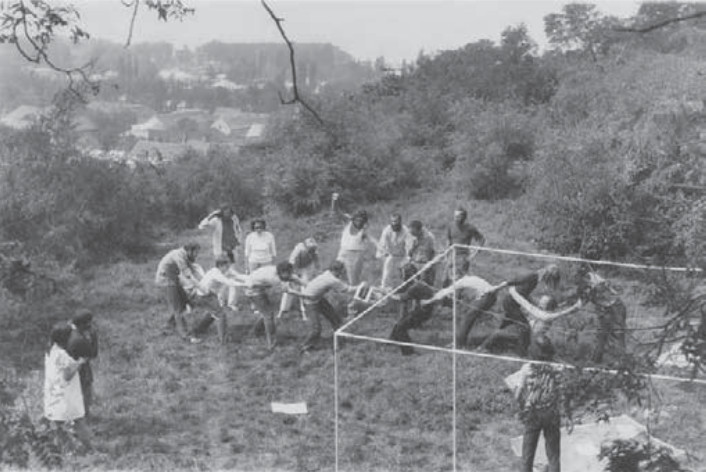Anselm Franke (ed.): Animism, 1 (2010)
Filed under book | Tags: · aesthetics, animal, animism, art, art history, ethnography, film, nature, spiritualism, things

“What is the role of aesthetic processes in the drawing of the boundaries between nature and culture, humans and things, the animate and inanimate? Structured around the aesthetic processes and effects of animation and mummification, Animism—a companion publication to the long-term exhibition of the same title, which premiered at Extra City Kunsthal Antwerpen in January 2010—brings together artistic and theoretical perspectives that reflect on the boundary between subjects and objects, and the modern anxiety that accompanies the relation between “persons” and “things.”
With works by Agency, Art & Language, Christian W. Braune & Otto Fischer, Marcel Broodthaers, Paul Chan, Tony Conrad, Didier Demorcy, Walt Disney, Lili Dujourie, Jimmie Durham, Eric Duvivier, Harun Farocki, León Ferrari, Christopher Glembotzky, Victor Grippo, Brion Gysin, Luis Jacob, Ken Jacobs, Darius James, Joachim Koester, Zacharias Kunuk, Louise Lawler, Len Lye, Étienne-Jules Marey, Daria Martin, Angela Melitopoulos & Maurizio Lazzarato, Wesley Meuris, Henri Michaux, Santu Mofokeng, Vincent Monnikendam, Tom Nicholson, Otobong Nkanga, Reto Pulfer, Félix-Louis Regnault, Józef Robakowski, Natascha Sadr Haghighian, Paul Sharits, Yutaka Sone, Jan Švankmajer, David G. Tretiakoff, Rosemarie Trockel, Anne-Mie Van Kerckhoven, Dziga Vertov, Klaus Weber, Apichatpong Weerasethakul.”
With contributions by Agency, Irene Albers, Oksana Bulgakowa, Edwin Carels, Bart De Baere, Didier Demorcy, Brigid Doherty, Sergei Eisenstein, Anselm Franke, Masato Fukushima, Avery F. Gordon, Richard William Hill, Darius James, Gertrud Koch, Joachim Koester, Bruno Latour, Maurizio Lazzarato and Angela Melitopoulos, Vivian Liska, Henri Michaux, Santu Mofokeng, Philippe Pirotte, Florian Schneider, Erhard Schüttpelz, Michael Taussig, Eduardo Viveiros de Castro, Martin Zillinger.
Publisher Sternberg Press, Berlin, with Extra City – Kunsthal Antwerpen and M HKA – Museum of Contemporary Art, Antwerp, 2010
ISBN 9781933128955
256 pages
via chickpou
PDF (7 MB, updated on 2019-1-15)
Exhibition booklets: Muhka (EN), Muhka (NL), HKW (EN), HKW (DE).
Pavle Levi: Cinema by Other Means (2012–) [EN, SR]
Filed under book | Tags: · antifilm, art, art history, avant-garde, cinema, dada, experimental film, film, film history, film theory, lettrism, montage, structural film, surrealism, technology, yugoslavia

“Cinema by Other Means explores avant-garde endeavors to practice the cinema by using the materials and the techniques different from those commonly associated with the cinematographic apparatus. Using examples from both the historical and the post-war avant-garde — Dada, Surrealism, Lettrism, “structural-materialist” film, and more — Pavle Levi reveals a range of peculiar and imaginative ways in which filmmakers, artists, and writers have pondered and created, performed and transformed, the “movies” with or without directly grounding their work in the materials of film. The study considers artists and theorists from all over Europe — France, Italy, Soviet Union, Germany, Hungary — but it particularly foregrounds the context of the Yugoslav avant-garde. Cinema by Other Means offers the English-language reader a thorough explication of an assortment of distinctly Yugoslav artistic phenomena, such as the Zenithist cine-writings of the 1920s, the proto-structural Antifilm movement of the early 1960s, and the “ortho-dialectical” film-poetry of the 1970s.”
Publisher Oxford University Press, 2012
ISBN 019984142X, 9780199841424
224 pages
Reviews: Matilde Nardelli (Oxford Art Journal, 2013), Greg DeCuir (Jump Cut, 2013), Bojan Jovic (Biblid, 2013, SR).
Exh. review: De Cuir (ARTMargins, 2013).
Cinema by Other Means (English, 2012, updated on 2024-4-26)
Kino drugim sredstvima (Serbian, trans. Đorđe Tomić, 2013, added on 2024-4-26)
Mutually: Communities of the 1970s and 1980s / Navzájem: Společenství 70. a 80. let, catalogue (2013) [EN/SK/CZ]
Filed under catalogue | Tags: · 1970s, 1980s, archive, art, art history, counterculture, czechoslovakia, film, hungary, participation, photography, video

Catalogue for an exhibition held in March-May 2013 at tranzitdisplay in Prague and The Brno House of Arts, Czech Republic, curated by Barbora Klímová, Daniel Grúň and Filip Cenek.
The selected fragments in this exhibition, borrowed from the archives of Moravian, Slovak, and Hungarian artists, reference different communities within the framework of “unofficial culture” during the period of Czechoslovak normalisation in the 1970s-80s.
Publisher tranzitdisplay, Prague, and The House of Arts, Brno, 2013
44 pages
via Academia.edu

